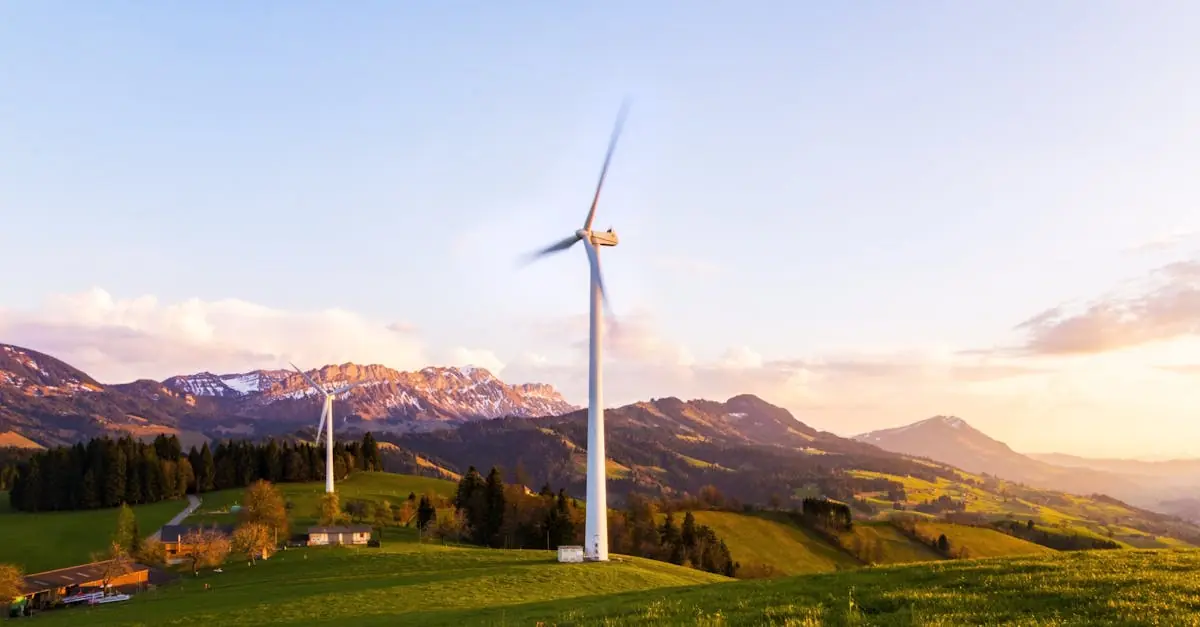Table of Contents
ToggleWind turbines are the rock stars of renewable energy, spinning away to harness nature’s power. But like any diva, they need a little TLC to keep performing at their best. Enter the wind turbine maintenance checklist—a must-have for anyone looking to ensure their turbines stay in tip-top shape and avoid unexpected meltdowns.
Importance of Wind Turbine Maintenance
Regular maintenance protects the investment in wind turbines and ensures their efficiency. Neglected turbines can lead to decreased energy production and costly repairs. Monitoring components like blades, gearboxes, and generators enhances reliability, maximizing uptime. Scheduled inspections identify wear or fatigue, preventing unexpected failures.
Effective maintenance increases the lifespan of each turbine by detecting issues early. Addressing minor problems prevents them from escalating into major concerns, reducing overall operational costs. Maintenance checks also enhance safety for personnel by ensuring that all systems function correctly.
Adherence to a structured maintenance checklist streamlines the process and covers critical areas such as lubrication, electrical systems, and safety features. Technicians perform visual inspections, checking for damage or debris that could affect performance. Regular cleaning of blades reduces the buildup of dirt, ensuring optimal aerodynamics.
Furthermore, timely maintenance contributes to compliance with regulatory standards, avoiding potential fines. Emphasizing a proactive maintenance strategy improves overall productivity and efficiency across wind farms. Through diligent upkeep, wind energy remains a viable, sustainable option for the future, supporting the global shift towards renewable resources.
Key Components of the Wind Turbine Maintenance Checklist
A comprehensive checklist ensures effective maintenance of wind turbines. Key components include mechanical, electrical, and safety systems.
Mechanical Components
Mechanical components require regular inspection for wear and tear. Technicians assess blades for cracks, leading edges for erosion, and bearings for noise or vibration. Gearboxes demand lubrication checks to prevent overheating. Inspecting yaw and pitch systems confirms operational efficiency. Overall, addressing mechanical issues enhances turbine reliability and extends operational life.
Electrical Components
Electrical systems play a crucial role in turbine performance. Technicians inspect wiring for insulation damage and loose connections. Regular checks of control panels ensure functionality, while testing sensors aids in performance monitoring. Inverters require attention to guarantee seamless energy conversion. Keeping electrical components in top condition minimizes downtime and maximizes energy output.
Safety Equipment
Safety equipment is essential for operational integrity. Inspecting emergency brake systems ensures they engage properly during critical situations. Technicians must check locking mechanisms on service doors to prevent accidental access. Regular examination of fire detection systems keeps personnel safe during emergencies. Maintaining proper Personal Protective Equipment reduces risks during maintenance tasks.
Routine Maintenance Procedures
Routine maintenance is crucial for optimizing the performance of wind turbines. It ensures reliability, safety, and extended operational life.
Daily Checks
Daily checks involve visual inspections of the turbine. Technicians confirm the presence of any unusual noises or vibrations that might indicate issues. They also examine the condition of blades, looking for signs of damage or wear. Maintaining proper lubrication levels is essential; hence, oil levels should be verified daily. This immediate attention helps in identifying problems early.
Monthly Checks
Monthly checks require a more thorough inspection of key components. Technicians assess the gearbox and braking systems for operational effectiveness. Evaluating electrical connections and control systems is vital to maintain efficiency. Furthermore, cleaning and checking debris on blades enhances aerodynamic performance. Regular monitoring of these components prevents the accumulation of potential problems.
Annual Inspections
Annual inspections provide a comprehensive evaluation of the entire turbine system. Professionals conduct detailed assessments of mechanical and electrical components. They evaluate the condition of the tower structure for any signs of corrosion or wear. Safety systems, including emergency brakes, require thorough testing to ensure functionality. Dedicating time to these inspections prolongs turbine life and enhances overall productivity.
Common Issues and Troubleshooting
Wind turbines face various operational challenges that require attention. Identifying common issues early enhances performance and efficiency.
Mechanical Failures
Mechanical failures often stem from wear and tear on critical components. Blades may experience cracks or surface erosion due to harsh weather conditions. Gearboxes can fail if they lack proper lubrication, leading to overheating and gear degradation. Pitch systems might malfunction, affecting the angle of blades and reducing energy capture. Routine inspections detect these issues promptly. Technicians assess mechanical components regularly, maintaining optimal turbine performance and longevity.
Electrical Failures
Electrical failures can disrupt turbine functionality significantly. Issues may arise from damaged wiring or faulty connectors, resulting in operational downtime. Control panels require close monitoring to ensure they transmit accurate performance data. Inverters must function correctly to convert generated energy into usable power. Scheduled checks on electrical systems identify these potential risks, allowing for timely repairs. Technicians prioritize inspecting these components, minimizing disruptions and ensuring consistent energy output.
Best Practices for Effective Maintenance
Effective maintenance practices enhance the performance and lifespan of wind turbines. Incorporating a thorough approach ensures technicians address issues proactively.
Documentation and Reporting
Documentation serves as the backbone of maintenance efforts. Keeping detailed logs of inspections aids in tracking the condition of equipment. Furthermore, records of repairs and replacements provide a historical perspective on turbine health. Consistent reporting maintains transparency and accountability within maintenance teams. Using standardized forms improves efficiency and ensures compliance with regulatory requirements. Tracking patterns in equipment failures assists in anticipating future problems, allowing for timely interventions.
Training for Maintenance Personnel
Training plays a crucial role in effective turbine maintenance. Skilled personnel enhance the accuracy and efficiency of maintenance tasks. Continual education programs ensure technicians stay updated on best practices and technological advancements. Workshops focusing on safety protocols minimize risks during maintenance procedures. Mentorship programs can further develop junior technicians, fostering a knowledgeable workforce. Having a well-trained team not only improves operational integrity but also leads to better communication among staff members. Regular assessments of training effectiveness also support continuous improvement within the maintenance program.
Conclusion
Regular maintenance of wind turbines is crucial for maximizing their efficiency and longevity. By following a structured maintenance checklist, technicians can ensure that all critical components are inspected and serviced on time. This proactive approach not only prevents costly repairs but also enhances energy production and operational safety.
Investing in routine checks and thorough documentation supports compliance with regulatory standards and fosters a culture of continuous improvement. A well-trained maintenance team is essential in executing these practices effectively. Prioritizing maintenance ultimately reinforces the reliability of wind energy as a sustainable power source for the future.








